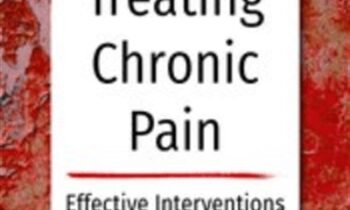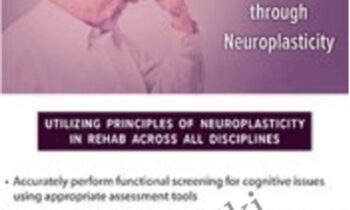Stroke Rehab for Patients who “Push”: Management Strategies for a Unique Patient Population – Michelle Green
Original price was: $199.99.$75.00Current price is: $75.00.
In Stock5 Hours 59 Minutes
Pushing behavior presents serious challenges during stroke rehabilitation. Patients who push are often low level, need a lot of assistance, have considerable safety concerns, and do not respond to typical treatment interventions. This recording will show you how to address the root causes of pusher syndrome.
Description
Accelerate your learning with the Stroke Rehab for Patients who “Push”: Management Strategies for a Unique Patient Population – Michelle Green course, priced at just Original price was: $199.99.$75.00Current price is: $75.00. on ESYSGB.com! Explore our extensive catalog of over 60,000 downloadable digital courses across Uncategorized. Experience flexible, self-paced learning from experts and save over 80%. Empower your future today!
Pushing behavior presents serious challenges during stroke rehabilitation. Patients who push are often low level, need a lot of assistance, have considerable safety concerns, and do not respond to typical treatment interventions. This recording will show you how to address the root causes of pusher syndrome.
This lab-intensive, recording will show you how to address the root causes of pusher syndrome with evidence-based treatment activities and progressions. Learn how to assess and address the limiting impairments of pusher patients, utilizing the ICF model and principles of neuroplasticity to select the right intervention at the right time, and to maximize treatment outcomes.
Additionally, appropriate assessment tools and functional performance tests will be practiced in order to apply treatment ideas in any environment. You will come away with techniques applicable to other patients who present with similar impairments such as difficulty with midline, retropulsion, trunk malalignments, postural control deficits, and gait dysfunction, making this course a great investment! This dynamic course will take your treatments to the next level!
- Discuss current literature regarding suggested pathology of “pusher syndrome”
- Recognize and list common characteristics and functional presentation of a patient who “pushes”
- Develop a skill set for understanding normal movement as well as executing task analysis for assessments of impairments limitations
- Discuss the criteria critical in categorizing the “pusher” patient as a low, mid, or high-level “pusher”
- Identify appropriate treatment interventions for the low, mid, and high-level “pusher” patient to specifically improve noted activity limitations
- Practice supporting and positioning techniques that enhance safely for the clinician and patient
- Strategize progressions of interventions to reduce impairments and lessen activity limitations to maximize participation for each patient with “pusher syndrome”
ICF MODEL AND ROLE IN ASSESSMENT AND TREATMENT
- ICF Models guide to clinical reasoning
- Levels of ICF definitions and examples
- Correlation with assessment, prognosis and treatment planning
PATHOPHYSIOLOGY OF “PUSHING”
- Role of vestibular system
- Localization of lesions correlating with “pushing”
- Thalamic lesions and “pushing”
- Role of graviceptive systems
- Best support for occurrence of “pushing”
COMMON CHARACTERISTICS OF “PUSHERS”
- Alignment faults (trunk, head, pelvis, femur)
- Movement dysfunction
- Midline deficits
- Other (sensory loss, visual, neglect, cognition)
ASSESSMENT TOOLS
- Tests to confirm presence of “Pushing”
- Outcome measures
- Role of upper and lower trunk assessment
TASK-ANALYSIS, HYPOTHESIS DRIVE APPROACH
- Why use this framework for clinical reasoning
- What is the framework
- How it guides tasks assessment and guides treatment choices
- How to execute a task analysis
- Neuroplasticity and directing treatment
choices - Motor control and motor learning theories on set-up and progression
TREATMENT SET-UP FOR SUCCESS (REDUCE RISK, IMPROVE SAFETY, IMPROVE OUTCOMES)
- Choosing a position for treatment
- Align patient for best results
- Activate muscles in coordinated sequenced fashion to mimic functional demands
- Rehabilitation of function
- Compensation or Recovery?
TREATMENT FOR THE LOW, MID AND HIGH-LEVEL “PUSHER”
- Primary characteristic for each level
- Starting point and progression
- Functional re-education considerations
- Use of objects, adjunct, and equipment in treatment
Tag: Stroke Rehab for Patients who “Push”: Management Strategies for a Unique Patient Population – Michelle Green Review. Stroke Rehab for Patients who “Push”: Management Strategies for a Unique Patient Population – Michelle Green download. Stroke Rehab for Patients who “Push”: Management Strategies for a Unique Patient Population – Michelle Green discount
Build a robust future with the Stroke Rehab for Patients who “Push”: Management Strategies for a Unique Patient Population – Michelle Green course at ESYSGB.com! Gain lifetime access to high-impact digital content, meticulously designed to boost your career and personal growth.
- Lifetime Access: Permanent and unlimited access to your purchased courses.
- Exceptional Savings: Enjoy discounts of up to 80% off original prices.
- Secure Payments: Your transactions are fully protected and safe.
- Practical Knowledge: Acquire actionable skills for immediate application.
- Instant Availability: Start learning right after completing your purchase.
- Cross-Device Access: Study seamlessly on any desktop, tablet, or mobile device.
Unlock your potential with ESYSGB.com!
Only logged in customers who have purchased this product may leave a review.




![Stroke Rehab for Patients who “Push”: Management Strategies for a Unique Patient Population - Michelle Green - eSys[GroupBuy] Stroke Rehab for Patients who “Push”: Management Strategies for a Unique Patient Population - Michelle Green](https://esysgb.com/wp-content/uploads/2021/06/Stroke-Rehab-for-Patients-who-Push-Management-Strategies-for-a-Unique-Patient-Population.jpg)




Reviews
There are no reviews yet.